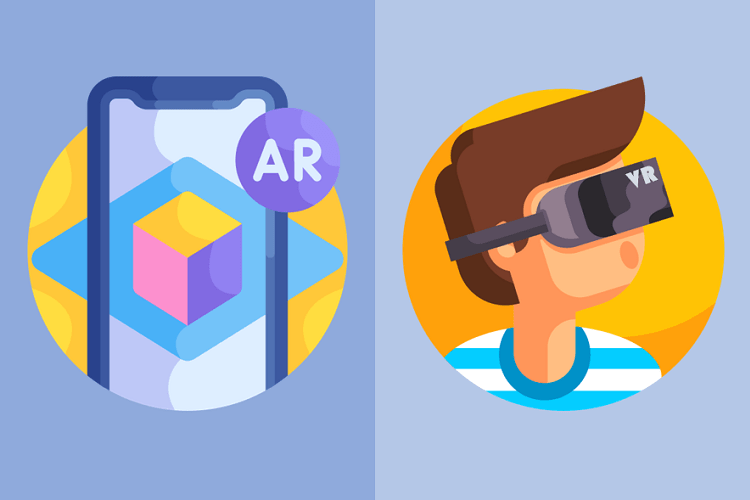Augmented reality and virtual reality are the two most transforming technologies that will change how to see and experience our surroundings. With the growing demand for an immersive experience, these two technologies are widely used across multiple industries, and the potential is immense.

Be it automotive, healthcare, education or gaming, augmented reality and virtual reality are changing the landscape of these industries. These advancements hold the potential to revolutionize the way we live and work.
AR and VR are not new to the market. Both technologies have been in use for many years in different industries. However, with the advancement in technology, their potential is being realized, gaining immense popularity. To understand the difference between augmented reality (AR) and virtual reality (VR), you need to know about their definitions, how they work and the benefits of both technologies.
What is Augmented Reality (AR)?
AR technology overlays digital content in the physical world. It enhances the existing environment by adding layers of information. For example, in an automotive setting, sales executives can use augmented reality to show a car’s features and specifications when the customer is looking at it.
The image is used for illustration purposes. We are not the owner or creator of the image.
Augmented technology offers on-the-go accessibility and a wide range of applications. The main advantage of AR is that it does not require users to be in a specific place or wear any special equipment. Instead, it is used with the help of a simple smartphone or tablet.
This advancement became popular from the advent of the smartphone game “Pokémon GO”, in which players catch Pokémon in their surroundings. Since then, AR has come a long way, developing more sophisticated and valuable applications.
How Does AR Work?
The working of AR is based on the “visual perception” principle. It uses the camera and sensors to capture the real-world environment. This data is then processed and used to create a digital overlay. This overlay is then displayed on the screen of the device. The user can interact with this overlay to get more information about the surroundings.
Applications Of Augmented Reality Solutions:
AR applications are used across multiple industries to streamline complex tasks and communication. Below are some of the critical advancements of AR development across different domains:
AR Apps for Navigation:
The use of AR in navigation helps drivers to get real-time information about their surroundings. For instance, an AR app can provide information about the traffic, landmarks, and points of interest. In addition, this technology streamlines the indoor and outdoor navigation process. AR-based navigation is highly accurate and efficient.
AR For Healthcare:
AR in healthcare helps doctors get a more accurate view of the patient’s body. It superimposes the patient’s medical scans on their live image. AR also allows doctors to plan surgeries and communicate with other team members.
AR In Education:
Teachers can use an augmented reality app to provide students with a more interactive and immersive learning experience. For example, it is used to create virtual simulations of real-world scenarios or historical events. AR also helps teachers better engage students in the classroom and make learning more fun and interesting.
Augmented Reality in Business:
AR is disrupting online and offline retail with its unique ability to blend the digital and physical worlds. AR apps provide product information, reviews, and recommendations to shoppers in real-time. In addition, AR is also used for in-store navigation, product visualization, and even real-time sizing.
Efficient Training:
AR is used to provide efficient and practical training for employees. It is used to create virtual simulations of real-world scenarios. For example, an airline company can use AR to create a virtual simulation of a passenger jet so that new employees can learn how to operate it.
Advantages Of Augmented Reality:
- AR is highly efficient and accurate. It is used to provide real-time information about the surroundings.
- AR does not require users to be in a specific place or wear any special equipment. It is used with the help of a simple smartphone or tablet.
- AR is widely applicable and can be used in a variety of industries.
- AR provides a more immersive and interactive experience than other technologies.
- AR helps users to understand their surroundings with an interactive experience better.
What is Virtual Reality (VR)?
VR technology creates an artificial environment that users can interact with. It is used to provide a simulated experience. For example, in a medical setting, VR is used to create a virtual environment of the human body so that doctors can practice surgeries.
VR headsets are used to immerse users in this artificial environment. The user can experience the virtual world using various input devices such as controllers or hand gestures.
The image is used for illustration purposes. We are not the owner or creator of the image.
How Does VR Work?
The working of VR is based on the principle of “immersion”. It uses various technologies such as head-mounted displays (HMDs), tracked motion controllers, and spatial audio to create an immersive experience for users. For a VR experience, a user needs a full-fledged setup in which they are entirely isolated from the real world.
To experience VR, a user needs to wear a VR headset. This headset covers the user’s eyes and displays a stereoscopic image. In addition, the use of different technologies such as head-tracking and 360-degree video allows users to experience a sense of immersion in the virtual world.
Applications Of VR:
VR is used across multiple industries to provide a uniquely immersive experience. Some of its critical applications are:
Gaming:
Gaming is the most popular application of VR. VR headsets have brought about a revolution in the gaming industry. With VR, gamers can now immerse themselves in virtual worlds and experience gaming like never before. As a result, gaming is the biggest market for VR.
Entertainment:
VR is also being used for entertainment purposes. For example, several VR movies and documentaries are available for users to watch. In addition, VR is also being used for live concerts and events. As the concept of virtual events is booming, VR is likely to play a significant role in this industry. In future, we will see more VR-based live events happening in the metaverse.
In training:
VR is also being used for training purposes. VR is used to create virtual simulations of real-world scenarios. It is done for various medical, military, and educational training applications. For example, VR trains employees to use specific tools or machinery.
Design:
VR is also used for design purposes. With VR, designers can now create 3D models of their designs and view them in a virtual environment. It allows them to understand the final product better and make changes if needed.
Marketing:
VR is also being used for marketing purposes. For example, companies use VR to create virtual previews of their products. It allows potential customers to understand better what the product looks like and how it works. In addition, VR is also used for brand building exercises.
Advantages Of Virtual Reality:
- The most significant advantage of VR is its ability to provide an immersive experience for users. It immerses users in a completely different world and allows them to interact with it.
- VR is highly interactive as it will enable users to interact with the virtual world using various input devices. It makes the experience more engaging and fun.
- VR also allows social interaction as users can interact with other people in virtual environments. It is done for gaming, entertainment, or training purposes.
- VR is used to create real-world simulations. It allows users to experience situations that they would otherwise not be able to explore.
- VR helps in the development of skills. VR is used to provide training in a safe and controlled environment.
Difference Between AR vs VR

Both technologies might look similar in their work and applications, but they are pretty different. The key difference between AR vs VR is that VR creates an entirely virtual environment while AR augments the real world with virtual elements.
- VR is used to create an artificial world that users can interact with. On the other hand, AR uses the real world as its base and adds virtual elements.
- VR headsets are used to completely immerse users in the virtual world, while AR headsets use lenses to overlay digital information on top of the user’s field of view.
- VR is used primarily for gaming and entertainment purposes, while AR is used for various training, design, and marketing applications.
- VR is more expensive to set up and requires higher technical expertise. AR is more user-friendly and can be used by anyone with a smartphone. VR headsets provide a more immersive experience than AR headsets.
How Can AR And VR Work Together?
There are several ways in which AR and VR can work together. One way is to use VR to create the virtual environment and AR to add additional elements. In this, VR is used to create the basic structure of the scene, while AR is used to add objects, text, and other information to it.
Another way is to use AR to enhance the VR experience. With AR, users can access additional information about the virtual world. This information can be anything from menus to character bios.
AR provides feedback about the user’s performance in VR games or training simulations. It helps in giving a more immersive experience for users.
VR and AR are also used together to create mixed reality experiences. It allows users to interact with the real world and the virtual world simultaneously.
Wrapping Up!
Both technologies are revolutionary, and they hold the potential to transform our lives. With the growing demand for VR and AR, we will see more innovative applications in the upcoming time.



